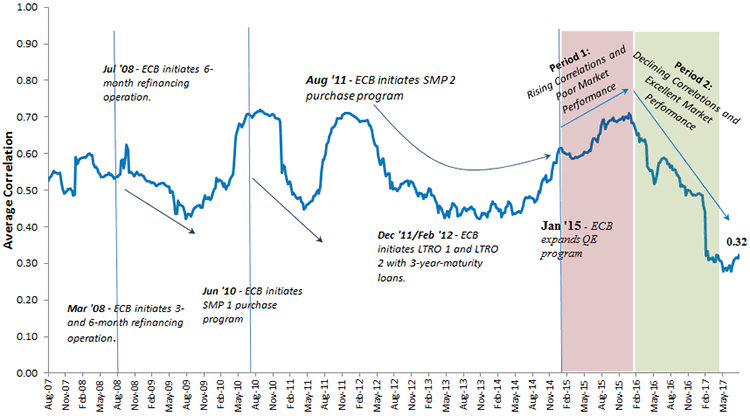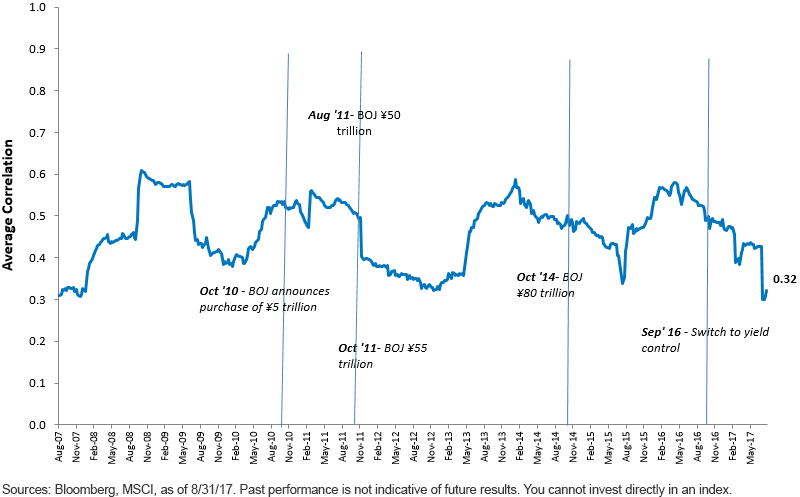What Global Correlations Mean For Portfolio Construction & Smart Beta
I recently wrote in a post how quantitative easing (QE) liquidity world average correlations have been dropping in the U.S. In this analysis, I will take it a step further and highlight how this trend is not just restricted to the U.S.; we see similar patterns globally, especially in Europe and Japan. In addition, I will talk about how investors should account for this while constructing their portfolios.
This pattern also calls into question the conventional narrative that exchange-traded funds (ETFs) are driving correlations higher and leading to systemic risk in the market.
Global Markets Offering Diversification & Potential Returns
While in the U.S. we are already on a rate hike trajectory, if we look globally, rates are still at their all-time lows. Ten-year yields in the developed world continue to be much lower compared to the U.S., barring a few exceptions like Australia.1
This is partly because other parts of the world are still coming out of an economic slowdown, with minimal signs of inflation. Thus, global central banks have been supportive of liquidity and fully supporting accommodative policies, while the U.S. is reducing its extraordinary measures of accommodation.
To visualize this interplay of local equities and prevailing average correlations, I plotted charts below for Japan and Europe. The charts plot the average of all possible pair-wise trailing six-month correlations of equities in the MSCI Euro Index for European equities and the Nikkei 225 for Japanese equities.
Eurozone Equity Average Correlations
6 Month - MSCI Euro
(Click on image to enlarge)

Japanese Equity Average Correlations
6 Monthly - Nikkei Index
(Click on image to enlarge)

Thus, falling correlations are not just a U.S. phenomenon—they are happening globally. My takeaways:
- For global asset allocators, global equities offer diversification opportunities.
- On an absolute basis, average correlations are lowest in the U.S. (around 0.18), and this coincides with economic recovery in the U.S.
- Those blaming passive inflows to ETFs for rising correlations have been falsely raising alarms.
Now let’s look at what rising or declining correlations imply for market performance in those periods. We define:
- Periods with rising correlation as any four consecutive weeks where average correlations rose more than 15%.
- Periods with declining correlation as any four consecutive weeks where average correlations declined more than 15%.

It’s clear that not just in the U.S. but globally periods of declining correlations led to favorable markets, in contrast to periods with rising correlations, which led to unfavorable markets.
Therefore, if global central banks are still accommodative, leading to global correlations following the path of U.S. correlations with a lag, there is scope for them to fall further, which could have a positive impact on local equities.
Takeaways for Portfolio Construction
Thus, it all comes down to how to implement this information in a portfolio. There are a few ways:
- Allocate Internationally: Allocation to international developed equities, especially in Europe and Japan, can provide upside in environments where global correlations follow the path of U.S. correlations.
- Stock Selection Matters: Along with asset allocation, investors need to seriously consider stock selection in order to tap into the maximum benefit that healthier firms can offer in investor portfolios. Investing in strategies that select fundamentally sound companies can enhance your selection effect and provide maximum benefit in a desynchronized, low-correlation environment.
- Smart Beta & ETFs Can Help: Finally, ETFs can provide not only diversification but also enhanced stock selection and weighting at prices lower than many active strategies.
The WisdomTree International Equity Index goes back to May 2006 and is a comprehensive strategy for exposure to developed world dividend-paying companies. In addition, for those who wish to avoid the complications of currency risk, we have a dynamic version as well called the WisdomTree Dynamic Currency Hedged International Equity Index. Applying a rules-based approach using a combination of factors, this strategy aims to hedge currency risk when not favorable.
1Source: Bloomberg, as of 9/31/17.
Disclaimer: Investors should carefully consider the investment objectives, risks, charges and expenses of the Funds before investing. U.S. investors only: To obtain a prospectus containing this ...
more


